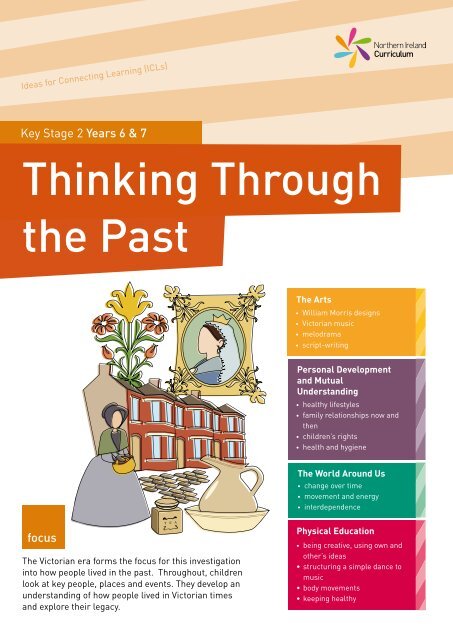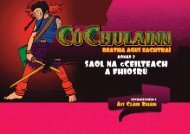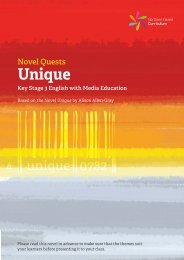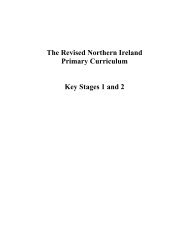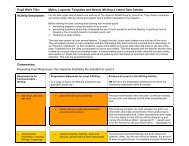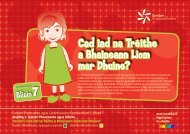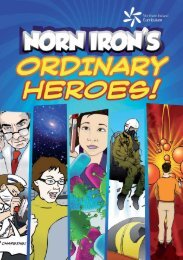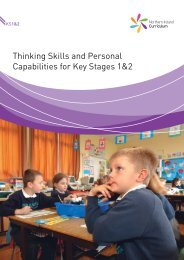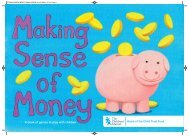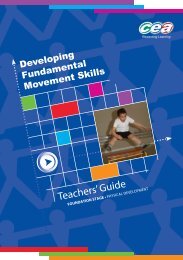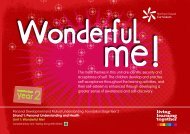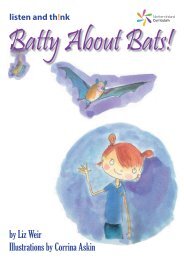Thinking Through the Past - Northern Ireland Curriculum
Thinking Through the Past - Northern Ireland Curriculum
Thinking Through the Past - Northern Ireland Curriculum
Create successful ePaper yourself
Turn your PDF publications into a flip-book with our unique Google optimized e-Paper software.
Ideas for Connecting Learning (ICLs)<br />
Key Stage 2 Years 6 & 7<br />
<strong>Thinking</strong> <strong>Through</strong><br />
<strong>the</strong> <strong>Past</strong><br />
focus<br />
The Victorian era forms <strong>the</strong> focus for this investigation<br />
into how people lived in <strong>the</strong> past. <strong>Through</strong>out, children<br />
look at key people, places and events. They develop an<br />
understanding of how people lived in Victorian times<br />
and explore <strong>the</strong>ir legacy.<br />
The Arts<br />
• William Morris designs<br />
• Victorian music<br />
• melodrama<br />
• script-writing<br />
Personal Development<br />
and Mutual<br />
Understanding<br />
• healthy lifestyles<br />
• family relationships now and<br />
<strong>the</strong>n<br />
• children’s rights<br />
• health and hygiene<br />
The World Around Us<br />
• change over time<br />
• movement and energy<br />
• interdependence<br />
Physical Education<br />
• being creative, using own and<br />
o<strong>the</strong>r’s ideas<br />
• structuring a simple dance to<br />
music<br />
• body movements<br />
• keeping healthy
Ideas for Connecting Learning (ICLs)<br />
Contents<br />
This ICL booklet ‘<strong>Thinking</strong> <strong>Through</strong> <strong>the</strong> <strong>Past</strong>’ contains <strong>the</strong> following:<br />
Suggested Learning Intentions and Activities for:<br />
The Arts 3<br />
Personal Development and Mutual Understanding 7<br />
The World Around Us 11<br />
Physical Education 15<br />
Contribution to <strong>the</strong> Development of Skills:<br />
Communication 19<br />
Using Ma<strong>the</strong>matics 19<br />
Using ICT 19<br />
<strong>Thinking</strong> Skills and Personal Capabilities 20<br />
Suggested Resources 21<br />
The Thematic Unit ‘Lets Get Moving’ has also been developed<br />
to support this ICL.<br />
1
focus<br />
The Victorian era forms <strong>the</strong><br />
focus for this investigation into<br />
how people lived in <strong>the</strong> past.<br />
<strong>Through</strong>out, children look at key<br />
people, places and events. They<br />
develop an understanding of how<br />
people lived in Victorian times and<br />
explore <strong>the</strong>ir legacy.<br />
The Arts<br />
William Morris designs<br />
Victorian music<br />
melodrama<br />
script-writing<br />
Personal Development<br />
and Mutual Understanding<br />
The World Around Us<br />
Physical Education<br />
3
4<br />
Ideas for Connecting Learning <strong>Thinking</strong> <strong>Through</strong> <strong>the</strong> <strong>Past</strong><br />
Hiss The Villain<br />
Suggested Learning Intentions<br />
Understand how physical gesture and expression can be used to refl ect<br />
emotion.<br />
Understand <strong>the</strong> basic structure of melodrama.<br />
Know how to write and perform a short melodrama.<br />
Suggested Activities<br />
Explore a range of facial expressions which best refl ect emotions such as<br />
happy, sad, worried, upset, frightened, terrifi ed, evil, angry etc. Explore<br />
a range of physical gestures which best refl ect feelings such as loving,<br />
anxious, frustrated, longing, menacing etc.<br />
Use traditional and digital sources to research <strong>the</strong> background to Victorian<br />
melodrama, writers and script. Look at some examples of short Victorian<br />
melodrama scripts such as The Tram-track Tragedy or Maria Marten and<br />
<strong>the</strong> Red Barn (available from Samuel French Ltd.,<br />
www.samuelfrench-london.co.uk). Discuss <strong>the</strong> basic characteristics of<br />
melodrama such as - good and evil, villain, hero/heroine, happy ending,<br />
exaggerated gestures and expressions, use of music to heighten emotion,<br />
use of costume and special effects. Develop, in pairs, freeze frames which<br />
suggest good and evil or villain and hero/heroine. These can be recorded<br />
using digital camera and speech bubbles added.<br />
In groups explore and perform <strong>the</strong> following short script:<br />
Villain: You must pay <strong>the</strong> rent. (hiss)<br />
Girl: I can’t pay <strong>the</strong> rent.<br />
(repeat both lines with more gestures and emotion)<br />
Villain: Then I will throw you out into <strong>the</strong> snow<br />
Hero: I’ll pay <strong>the</strong> rent<br />
Girl: My hero (cheer)<br />
In groups, devise a short melodrama. Begin with a basic plot of good and<br />
evil and <strong>the</strong>n add <strong>the</strong> villain, hero/heroine and any o<strong>the</strong>r characters that are<br />
needed. Use improvisation before writing <strong>the</strong> script.<br />
Develop <strong>the</strong> melodrama by adding appropriate music, costumes, props and<br />
any special effects you need such as sound and lighting. Perform <strong>the</strong> short<br />
melodrama and invite <strong>the</strong> o<strong>the</strong>r groups to interact with appropriate cheers<br />
and boos, etc.<br />
Record <strong>the</strong> melodramas using video camera or develop into a short fi lm<br />
and add special effects such as black and white or sound script. Visit <strong>the</strong><br />
schoolhouse in Cultra Folk Museum and perform <strong>the</strong> melodramas.
Inspired By Nature<br />
Suggested Learning Intentions<br />
Understand how artists may ga<strong>the</strong>r information to stimulate ideas.<br />
Know how to use <strong>the</strong> immediate environment to stimulate a personal<br />
response.<br />
Understand how <strong>the</strong> visual element and processes may be used to<br />
communicate ideas.<br />
Suggested Activities<br />
Use traditional and/or digital sources to research information about William<br />
Morris, Victorian textile designer, artist, furniture designer and writer.<br />
Discuss <strong>the</strong> variety of nature seen in his work – leaves, fl owers, birds, berries<br />
and buds - paying particular attention to <strong>the</strong> use of repeating patterns and<br />
discuss how realistic or imaginative his designs are.<br />
Design and make prints:<br />
Make a collection of foliage, such as leaves, fl owers or berries and use<br />
pen or pencil to make observational drawings recording any observed<br />
marks, shapes, patterns and lines.<br />
Choose three of <strong>the</strong> individual drawings in order to plan a print design,<br />
referring back to Morris’s work and discuss how he combined his leaves<br />
and fl owers to make one complete design.<br />
Combine <strong>the</strong> three separate drawings by sketching a new composition<br />
on a second page which can now be used as <strong>the</strong> basis for a printing tile<br />
(Easiprint).<br />
Engrave <strong>the</strong> design into a polystyrene tile, of <strong>the</strong> same proportion as <strong>the</strong><br />
drawing, using a blunt pencil or biro pen making good indentations in<br />
order to produce a clear print.<br />
Use rollers and water-based inks to ink <strong>the</strong> surface and place onto paper<br />
or fabric.<br />
Once <strong>the</strong> tile is carefully pulled from <strong>the</strong> surface, it may be inked again and<br />
<strong>the</strong> process repeated many times to create borders for a display board,<br />
lengths of fabric or paper coverings for containers. Add a second colour<br />
ei<strong>the</strong>r by cutting out sections of <strong>the</strong> tile and printing over <strong>the</strong> fi rst colour<br />
or by alternating colours for each new print. Single prints may be used to<br />
create cards or decorations for book covers.<br />
Present and display your work using traditional and digital means, including<br />
online environments such as Grid Club or <strong>the</strong> school website. Include all<br />
preparation drawings if appropriate. Identify and describe <strong>the</strong> various stages<br />
and processes involved. Talk about your ideas and listen to <strong>the</strong> ideas of<br />
o<strong>the</strong>rs in order to review and modify your work.<br />
5
6<br />
Ideas for Connecting Learning <strong>Thinking</strong> <strong>Through</strong> <strong>the</strong> <strong>Past</strong><br />
Come Into The Parlour<br />
Suggested Learning Intentions<br />
Understand that music can represent <strong>the</strong> attitudes and values of a culture.<br />
Understand that elements of music have changed.<br />
Know how to perform a short piece using voice and instruments.<br />
Suggested Activities<br />
Listen to pieces of music from <strong>the</strong> Victorian period such as, ‘Daisy Bell’ and<br />
‘Daddy Wouldn’t Buy me a Bow Wow’. Discuss when and where <strong>the</strong>y might<br />
have been listened to, for example, in <strong>the</strong> parlour in <strong>the</strong> evening or outside in<br />
<strong>the</strong> street.<br />
Use traditional and digital sources to research songs and music associated<br />
with <strong>the</strong> Victorian period focusing on music used or sung by children, for<br />
example, playground or street songs such as, ‘Dolly and her Mama’. Discuss<br />
<strong>the</strong> meaning behind some of <strong>the</strong>se songs and why <strong>the</strong>y were sung by children<br />
in this period of time. In groups, practise <strong>the</strong> songs and games and <strong>the</strong>n<br />
perform <strong>the</strong>m to <strong>the</strong> o<strong>the</strong>rs in <strong>the</strong> class.<br />
Write new lyrics for <strong>the</strong>se songs based on modern day events. Record and<br />
preserve <strong>the</strong> music: create a time capsule to be opened in future years.<br />
Visit a Victorian school such as Ballydown at Cultra, <strong>the</strong> Causeway School<br />
or <strong>the</strong> Ulster-American Folk Park at Omagh and dress appropriately for<br />
<strong>the</strong> occasion. Perform <strong>the</strong> songs and games. Record and present <strong>the</strong><br />
event using digital cameras, video or photographs. Plan, design and<br />
create a multimedia presentation using ICT software such as Slideshow or<br />
PowerPoint. Present to <strong>the</strong> school and publish on <strong>the</strong> school website.
focus<br />
The Victorian era forms <strong>the</strong><br />
focus for this investigation into<br />
how people lived in <strong>the</strong> past.<br />
<strong>Through</strong>out, children look at key<br />
people, places and events. They<br />
develop an understanding of how<br />
people lived in Victorian times and<br />
explore <strong>the</strong>ir legacy.<br />
Personal Development<br />
and Mutual<br />
Understanding<br />
healthy lifestyles<br />
family relationships now and <strong>the</strong>n<br />
children’s rights<br />
health and hygiene<br />
The Arts<br />
The World Around Us<br />
Physical Education<br />
7
8<br />
Ideas for Connecting Learning <strong>Thinking</strong> <strong>Through</strong> <strong>the</strong> <strong>Past</strong><br />
Healthy Lifestyles Then And Now<br />
Suggested Learning Intentions<br />
Understand <strong>the</strong> factors that contribute to a healthy lifestyle.<br />
Identify practical ways in which we can care for our bodies.<br />
Be aware of <strong>the</strong> importance of hygiene.<br />
Suggested Activities<br />
Discuss what makes a healthy lifestyle, focus on <strong>the</strong> benefi ts of exercise and<br />
eating a balanced diet.<br />
Use traditional and/or digital sources to research aspects relating to a<br />
‘Healthy Lifestyle’ in <strong>the</strong> Victorian period, particularly <strong>the</strong> fi rst 40 years of<br />
Victoria’s reign. Identify reasons why so many children in early Victorian<br />
times died before <strong>the</strong>y reached <strong>the</strong> age of 16. Investigate <strong>the</strong> effects of not<br />
having an adequate supply of clean water, clean air and proper sewers.<br />
Complete a water diary, by keeping a record of every occasion in a day that<br />
you use water. Compare and contrast this with slum streets where water<br />
was often only turned on for 20 minutes a day.<br />
Use <strong>the</strong> Internet to research pictures of a Victorian town and <strong>the</strong>ir own town/<br />
city today. Look in detail at <strong>the</strong> Victorian slums. Why did <strong>the</strong> residents suffer<br />
from bad health? Was this fair? Have things changed much? Are <strong>the</strong>re any<br />
similarities?<br />
Read about Dr Barnardo who helped improved living conditions for street<br />
children in London in Victorian times. Compare this with what is being done<br />
for <strong>the</strong> homeless today. Find out about <strong>the</strong> workhouse in your locality. Was it<br />
always a healthy place to be?<br />
Ask <strong>the</strong> class to fi nd out how <strong>the</strong> Victorians kept food fresh. Why was it a<br />
problem at this time? List ways of being hygienic with food. Ask <strong>the</strong> children<br />
to plan, design and create a balanced and tasty menu for an imaginary<br />
restaurant in Victorian times, do <strong>the</strong> same for a typical meal in a Victorian<br />
slum. Compare <strong>the</strong> two. Finish by asking <strong>the</strong>m to draw up a personal action<br />
plan, using ICT, to do one thing each day that will improve <strong>the</strong>ir health.
Article 32<br />
Suggested Learning Intentions<br />
Know about <strong>the</strong> rights of <strong>the</strong> child.<br />
Recognise how working conditions have improved and how children’s<br />
rights are protected.<br />
Compare and contrast different lifestyles of children from different<br />
countries and eras.<br />
Know about <strong>the</strong> work carried out by organisations to improve <strong>the</strong> lives of<br />
children.<br />
Know what exploitation is.<br />
Suggested Activities<br />
Find out <strong>the</strong> legal age to start part-time or full-time work.<br />
Make a list of <strong>the</strong> variety of jobs that <strong>the</strong> class do in school, and paid or<br />
unpaid jobs at home or in <strong>the</strong> community.<br />
Use traditional and/or digital sources to research <strong>the</strong> work that children did<br />
in Victorian Times and list <strong>the</strong> dangers, for example, match girls, climbing<br />
boys, trappers, mill workers and brickyard workers. Look at Charles<br />
Kingsley’s The Water Babies. Create a daily log for a given job, for example,<br />
a trapper down a mine. Compare it to a typical day in <strong>the</strong> life of a child now.<br />
As a class, decide who has a safer and healthier life and think of <strong>the</strong> reasons<br />
why. Imagine you are a climbing boy talking to a politician about your job.<br />
Describe <strong>the</strong> dangers of <strong>the</strong> job.<br />
Imagine you are one of Lord Shaftesbury’s inspectors. Write a report<br />
highlighting <strong>the</strong> terrible conditions children had to endure. Are <strong>the</strong>se jobs<br />
allowed today? Use traditional and digital sources to research <strong>the</strong> work<br />
of Lord Shaftesbury, Thomas Barnardo and Sir Robert Peel who fought for<br />
<strong>the</strong> rights of child workers in order to improve <strong>the</strong>ir health, safety, living<br />
conditions and education. Compare <strong>the</strong> child working in Victorian times to<br />
a children working today in developing world countries and o<strong>the</strong>r areas of<br />
deprivation.<br />
Think about <strong>the</strong> issues of child labour, here and abroad. Find out about <strong>the</strong><br />
conditions that some children still face due to dangerous working conditions<br />
and exploitation. Refl ect on <strong>the</strong> causes and effects of inequality. Research<br />
case studies of situations where children’s rights have been denied, in this<br />
country and overseas.<br />
Examine <strong>the</strong> United Nations Convention on <strong>the</strong> Rights of <strong>the</strong> Child (UNCRC).<br />
Research <strong>the</strong> acts passed in Victorian times, which made work a safer place<br />
to be, for example, 1842 Mines Act, 1847 Factory Act. Use organisations such<br />
as RUGMARK to help understand <strong>the</strong> initiatives that are addressing <strong>the</strong>se<br />
same issues today.<br />
NB:<br />
When discussing <strong>the</strong> UNCRC, emphasise to children that <strong>the</strong> convention applies<br />
to all children; whoever or wherever <strong>the</strong>y are.<br />
9
10<br />
Ideas for Connecting Learning <strong>Thinking</strong> <strong>Through</strong> <strong>the</strong> <strong>Past</strong><br />
That’s Not Fair<br />
Suggested Learning Intentions<br />
Be aware of different learning styles.<br />
Identify and practice ways to improve learning.<br />
Suggested Activities<br />
Research a typical Victorian school day, using traditional and/or digital<br />
sources. Find out about <strong>the</strong> typical Victorian timetable, lessons, class<br />
size and discipline. Organise a Victorian school day (desks in rows, make<br />
children stand, learn tables by rote, have Victorian lessons and be very<br />
stern!).<br />
Read extracts about Victorian schooling (Nicholas Nickleby by Charles<br />
Dickens or Tom Brown’s Schooldays by Thomas Hughes).<br />
Compare a Victorian school timetable with one from your own classroom.<br />
Are <strong>the</strong>re any similarities and/or differences?<br />
Consider why children from rich families had a much better chance of<br />
education than poor children. Why did this happen, comment on <strong>the</strong><br />
injustices involved.<br />
Investigate <strong>the</strong> different ways we learn today and identify your own preferred<br />
learning style.<br />
Find out how and why children were punished (cane, ruler, dunce’s cap).<br />
Refl ect on whe<strong>the</strong>r <strong>the</strong>se were fair methods of punishment.<br />
In 1880 <strong>the</strong> school leaving age was raised from 10 to 13. Debate whe<strong>the</strong>r<br />
leaving at 13, ra<strong>the</strong>r than 16, would be a good idea today.
focus<br />
The Victorian era forms <strong>the</strong><br />
focus for this investigation into<br />
how people lived in <strong>the</strong> past.<br />
<strong>Through</strong>out, children look at key<br />
people, places and events. They<br />
develop an understanding of how<br />
people lived in Victorian times and<br />
explore <strong>the</strong>ir legacy.<br />
The World Around Us<br />
change over time<br />
movement and energy<br />
interdependence<br />
The Arts<br />
Personal Development<br />
and Mutual Understanding<br />
Physical Education<br />
11
12<br />
Ideas for Connecting Learning <strong>Thinking</strong> <strong>Through</strong> <strong>the</strong> <strong>Past</strong><br />
Famine And Emigration<br />
Suggested Learning Intentions<br />
Understand <strong>the</strong> impact of change over time.<br />
Suggested Activities<br />
Find out about what happened when <strong>the</strong> potato crop failed in 1845/46.<br />
Examine types of evidence to fi nd out what life was like during <strong>the</strong> famine.<br />
Make a drama presentation going back in time to <strong>the</strong> famine. Investigate<br />
famine and emigration at <strong>the</strong> Ulster-American Folk Park. Find out <strong>the</strong><br />
destinations of emigrants around <strong>the</strong> world. Outline <strong>the</strong> factors that<br />
infl uence people to move to ano<strong>the</strong>r country. Interview someone who has<br />
lived in ano<strong>the</strong>r country or someone who has moved to Nor<strong>the</strong>rn <strong>Ireland</strong><br />
from ano<strong>the</strong>r country, for example, Lithuania or Poland. Look at <strong>the</strong> causes<br />
and consequences of a modern famine.<br />
How popular are potatoes today? Design and carry out a survey to fi nd out<br />
some of <strong>the</strong> different ways in which <strong>the</strong>y are used, consumed and how <strong>the</strong>y<br />
can form part of a healthy diet. Find out <strong>the</strong> variety of potatoes that <strong>the</strong>re<br />
are. Invite a local farmer to talk about growing potatoes from seed. Think<br />
about a range of ways to fi nd out about <strong>the</strong> lifecycle of <strong>the</strong> potato. Investigate<br />
conditions for growing potatoes. Use ICT, such as, a digital camera to record<br />
observations of growth over time. Collect traditional potato recipes and<br />
create a class recipe book. Cook some of <strong>the</strong> favourite recipes or create new<br />
recipes. Discuss <strong>the</strong> importance of food hygiene and safety. Consider <strong>the</strong><br />
possibility of an enterprise project, for example, trading recipes or recipe<br />
books, organising a campaign to encourage healthy eating or invite parents<br />
into school to illustrate <strong>the</strong>ir learning journey to date.
Personalities<br />
Suggested Learning Intentions<br />
Understand <strong>the</strong> impact that people have made.<br />
Understand that <strong>the</strong>re may be a range of possible solutions to a problem.<br />
Suggested Activities<br />
Use traditional and/or digital sources as ‘The Victorians’ CD Rom to<br />
research, analyse and present work on <strong>the</strong> following:<br />
Queen Victoria:<br />
Examine Queen Victoria’s family tree. Discuss how Queen Victoria came<br />
to <strong>the</strong> throne when her fa<strong>the</strong>r was not King. What age was she when<br />
she became Queen, and when did she die? What were <strong>the</strong> names of her<br />
children? Why did her eldest child not become Queen? What was Queen<br />
Victoria really like? Watch an extract of <strong>the</strong> fi lm ‘Mrs Brown’. Collect<br />
evidence, including pictures of statues or portraits of her. Discuss <strong>the</strong><br />
reliability of different types of evidence and how <strong>the</strong> impression of Queen<br />
Victoria as a stern, humourless person remains. Compare photos, written<br />
evidence and diary extracts. Highlight <strong>the</strong> difference between what is a fact<br />
and what is a point of view. In groups make a timeline of her life or focus<br />
on different aspects of her personality and write a relevant obituary, for<br />
example, <strong>the</strong> loving caring wife of Albert or <strong>the</strong> stern, sullen Queen.<br />
Brunel:<br />
Consider why Brunel was so famous. Find out about his work on <strong>the</strong> Clifton<br />
Suspension Bridge. Compare this bridge with o<strong>the</strong>r bridges both in <strong>the</strong><br />
local area and around <strong>the</strong> world. In small groups think about <strong>the</strong> purpose<br />
of bridges, <strong>the</strong> materials <strong>the</strong>y are made from, shapes used in <strong>the</strong>ir building,<br />
where <strong>the</strong>y are located and/or <strong>the</strong>ir place in history. Experiment with a<br />
variety of materials to design and build bridges for different purposes, for<br />
example, to hold a specifi c weight, to span a given gap or one that can open<br />
and close (a drawbridge).<br />
13
14<br />
Ideas for Connecting Learning <strong>Thinking</strong> <strong>Through</strong> <strong>the</strong> <strong>Past</strong><br />
Using Evidence<br />
Suggested Learning Intentions<br />
Understand how people and places change over time.<br />
Understand that <strong>the</strong>re may be a range of possible solutions to a problem.<br />
Suggested Activities<br />
Examine a modern map of a local town or any town with connections to<br />
Victorian times. Highlight <strong>the</strong> street names, buildings or places with Victoria<br />
or Albert in <strong>the</strong>ir name. Examine pictures of <strong>the</strong>se buildings and o<strong>the</strong>r<br />
Victorian buildings and discuss why Victorian times have had such a lasting<br />
impact.<br />
Go on a walk or trail to fi nd evidence of Victorian life (depending on <strong>the</strong><br />
location of your school). Use a digital camera to record images. Focus on<br />
a single building, for example, a church, terraced house, railway building or<br />
industrial building. Identify <strong>the</strong> changes in <strong>the</strong> building by examining some<br />
‘<strong>the</strong>n and now’ photographs. Discuss what <strong>the</strong> function of <strong>the</strong> building was<br />
and is, <strong>the</strong> materials used and any striking points of architectural design or<br />
decoration. Then design and construct an example of a Victorian building.<br />
Use traditional or digital maps to examine back-to-back houses in a Victorian<br />
city. Read a contemporary factual account of life in such a house. Use <strong>the</strong>se<br />
sources to list <strong>the</strong> problems for people living in such an environment. Watch<br />
<strong>the</strong> fi rst episode of <strong>the</strong> Channel 4 programme “1900 House”. Discuss how<br />
<strong>the</strong> modern house was changed to become <strong>the</strong> 1900 house. Discuss what<br />
sort of people would have lived in a house like this. List any similarities and<br />
differences between this house and a back-to-back house. Think about <strong>the</strong><br />
possible problems <strong>the</strong> family will have when <strong>the</strong>y live in <strong>the</strong> 1900 house.<br />
Use ICT software such as Turtle or Designer to compare a plan of a Victorian<br />
house with a present day house.<br />
Examine a photograph of a middle class Victorian parlour. Think about<br />
questions such as how many different patterns are <strong>the</strong>re? How would <strong>the</strong><br />
room be lit? How many pictures, statues and plants are <strong>the</strong>re? What types<br />
of activity would go on in this room?<br />
List <strong>the</strong> duties of a ‘maid-of-all work’ in a middle class Victorian household.<br />
Write a diary extract for her, illustrating what she feels about her day.<br />
Examine <strong>the</strong> plan or cross section of a rich family’s house in Victorian times.<br />
Identify unusual room names, for example, scullery and pantry and fi nd<br />
out what <strong>the</strong>y were for. Find out about <strong>the</strong> amount of servants needed in a<br />
large house and write a job description for each type of servant. Investigate<br />
<strong>the</strong> rules <strong>the</strong> servants had to obey and discuss why <strong>the</strong> amount of people in<br />
domestic service eventually declined.<br />
Visit a National Trust house and, with <strong>the</strong> rest of your class, re-enact a day<br />
in that house by taking on <strong>the</strong> roles of ei<strong>the</strong>r a member of <strong>the</strong> family or a<br />
servant.
focus<br />
The Victorian era forms <strong>the</strong><br />
focus for this investigation into<br />
how people lived in <strong>the</strong> past.<br />
<strong>Through</strong>out, children look at key<br />
people, places and events. They<br />
develop an understanding of how<br />
people lived in Victorian times and<br />
explore <strong>the</strong>ir legacy.<br />
Physical Education<br />
being creative, using own and o<strong>the</strong>r’s<br />
ideas<br />
structuring a simple dance to music<br />
body movements<br />
keeping healthy<br />
The Arts<br />
Personal Development<br />
and Mutual Understanding<br />
The World Around Us<br />
15
16<br />
Ideas for Connecting Learning <strong>Thinking</strong> <strong>Through</strong> <strong>the</strong> <strong>Past</strong><br />
It’s Playtime<br />
Suggested Learning Intentions<br />
Recognise how <strong>the</strong> body feels at rest and when exercising.<br />
Understand <strong>the</strong> relationship between physical activity and good health.<br />
Understand <strong>the</strong> effects of exercise on <strong>the</strong> body.<br />
Be able to co-operate with o<strong>the</strong>rs.<br />
Suggested Activities<br />
Use traditional and/or digital sources to research what games were played<br />
at school during <strong>the</strong> Victorian period. Discuss <strong>the</strong> meaning behind some<br />
of <strong>the</strong>se games. In groups, choose one of <strong>the</strong> games and fi nd out more<br />
information about it. Record how to play <strong>the</strong> game and explain any rules.<br />
Present your game to o<strong>the</strong>rs using PowerPoint or Slideshow. Take it in turns<br />
to teach <strong>the</strong>ir game to <strong>the</strong> rest of <strong>the</strong> class.<br />
Examples of games: skittles, marbles, hopscotch, tag, ‘<strong>the</strong> farmer wants a<br />
wife’, hide and seek, traffi c lights, ‘what time is it mister wolf?’, ring games,<br />
oranges and lemons. Skip using rhymes or traditional chants.<br />
Discuss <strong>the</strong> importance of keeping fi t and healthy and how playground<br />
games and activities can help this.
School Days<br />
Suggested Learning Intentions<br />
Be able to perform movement phrases using a range of body parts and<br />
actions.<br />
Be able to explore a variety of movement actions.<br />
Work creatively with o<strong>the</strong>rs, using own and o<strong>the</strong>rs’ ideas.<br />
Suggested Activities<br />
Pre-Lesson:<br />
Discuss what school was like in Victorian times. Did everyone go to school<br />
and what did <strong>the</strong>y wear? How did <strong>the</strong>y get <strong>the</strong>re? What was school like and<br />
what did <strong>the</strong>y do? Compare this with present day schools.<br />
Schoolyard Fun and Games:<br />
Recap on <strong>the</strong> games learnt. Plan a short sequence of movements to music<br />
to depict playing <strong>the</strong> games, for example, hopscotch, leapfrog your partner<br />
and imagine playing tag, running away, dodging from side to side, being<br />
caught and freezing in mid-action. Plan, practise and perform a short<br />
schoolyard sequence of movements.<br />
In <strong>the</strong> Schoolroom:<br />
Create a list of all <strong>the</strong> activities that may have taken place in a Victorian<br />
schoolroom, for example, writing, reading, roll call. Think of <strong>the</strong> ways that<br />
pupils might have answered to <strong>the</strong>ir name (stand up and say name, raise<br />
arm). How could you demonstrate writing (exaggerate writing using an arm,<br />
making actions big and continuous)? How might <strong>the</strong>y have held <strong>the</strong>ir book<br />
when reading? Practise different postures, using different levels.<br />
Create, practise and perform a short sequence to demonstrate <strong>the</strong> roll call,<br />
reading and writing in a Victorian schoolroom.<br />
Movement Sequence:<br />
In pairs, create and practise a short movement sequence to depict a school<br />
day in Victorian times. For example: playing in <strong>the</strong> schoolyard, bell rings,<br />
all line up, in <strong>the</strong> classroom working, <strong>the</strong>n playtime again. Demonstrate<br />
<strong>the</strong> sequence to o<strong>the</strong>rs and discuss and evaluate <strong>the</strong> range of movement<br />
sequences.<br />
17
Contribution to <strong>the</strong> Development of Skills<br />
<strong>Through</strong>out <strong>the</strong> areas within this ICL <strong>the</strong>re are opportunities to provide experiences which<br />
help to develop <strong>the</strong> skills of Communication, Using Ma<strong>the</strong>matics, Using ICT and <strong>Thinking</strong><br />
Skills and Personal Capabilities.<br />
Communication<br />
Use a wide range of sources to locate and make use of relevant<br />
information.<br />
Present and communicate work in a range of forms and a variety of ways.<br />
Organise and structure work independently.<br />
Begin to make inferences and draw conclusions.<br />
Using Ma<strong>the</strong>matics<br />
Within purposeful contexts identify, collect and record data.<br />
Find information from a range of graphs and diagrams and draw<br />
conclusions.<br />
Design and use a decision tree to sort or identify a group of objects.<br />
Use vocabulary associated with probability.<br />
Measure, using correct notation and read scales with an appropriate<br />
degree of accuracy.<br />
Make sensible estimates, and where appropriate choose and use metric<br />
units.<br />
Use <strong>the</strong> four number operations to solve problems.<br />
Using ICT<br />
Research, select, edit, organise and present information/assets using a range<br />
of digital sources.<br />
Process found or self-produced assets, including text, number, sound, still or<br />
moving images, and combine <strong>the</strong>se to create, present and communicate <strong>the</strong>ir<br />
work, showing an awareness of audience and purpose.<br />
Communicate and develop ideas by creating and editing text onscreen,<br />
combining this with appropriate selected images and/or sound.<br />
Use contemporary digital methods to communicate, share and exchange<br />
information with peers.<br />
Investigate and solve problems in a digital environment.<br />
19
20<br />
Ideas for Connecting Learning <strong>Thinking</strong> <strong>Through</strong> <strong>the</strong> <strong>Past</strong><br />
<strong>Thinking</strong> Skills and Personal Capabilities<br />
Managing Information: Asking deeper and wider questions to clarify <strong>the</strong> task,<br />
to plan and to set goals. Having a sense of audience and purpose. Developing<br />
methods for collating and recording information and monitoring progress on a<br />
task.<br />
<strong>Thinking</strong>, Problem-Solving and Decision-Making: Identifying patterns and<br />
relationships. Explaining and justifying methods, opinions and conclusions.<br />
Making and testing predictions, and linking possible causes and effects.<br />
Discriminating between fact and opinion. Understanding more than one point<br />
of view. Examining options and weighing up pros and cons. Trying alternative<br />
solutions and approaches.<br />
Being Creative: Experimenting in a playful way. Seeking out problems and<br />
challenging <strong>the</strong> routine method. Seeing opportunities in mistakes and failures.<br />
Building on own and o<strong>the</strong>rs’ ideas and experiences, using all <strong>the</strong> senses.<br />
Experimenting with different designs, actions and outcomes. Valuing o<strong>the</strong>r<br />
people’s ideas.<br />
Working with O<strong>the</strong>rs: Becoming independent. Understanding and responding<br />
to feedback. Taking responsibility for tasks and roles in groups. Working to<br />
reach agreements and beginning to manage disagreements.<br />
Self Management: Becoming self-directed by working on own. Working<br />
towards personal targets. Evaluating what <strong>the</strong>y are learning and comparing<br />
<strong>the</strong>ir approaches with o<strong>the</strong>rs. Identifying how <strong>the</strong>ir learning might be <strong>the</strong> same/<br />
different in different contexts.
Suggested Resources <strong>Thinking</strong> <strong>Through</strong> <strong>the</strong> <strong>Past</strong><br />
Digital Resources<br />
ICT Software Suggested Websites<br />
Designer<br />
Number Magic or Numberbox 2<br />
Slideshow or Powerpoint<br />
Victorians CD-Rom<br />
Amnesty International<br />
www.amnesty.org.uk<br />
BBC History For Kids<br />
www.bbc.co.uk/history/forkids<br />
BBC Nor<strong>the</strong>rn <strong>Ireland</strong> Learning<br />
www.bbc.co.uk/ni/learning<br />
Learnthings – online learning from The Guardian<br />
www.learn.co.uk/<br />
Museums and Galleries Nor<strong>the</strong>rn <strong>Ireland</strong><br />
www.magni.org.uk<br />
NAACE – Advancing Education through ICT<br />
www.mape.org.uk/kids<br />
One World Centre Citizenship<br />
www.bigpic.biz<br />
Online resource database<br />
www.clickteaching.co.uk<br />
Oxfam – Cool Planet<br />
www.oxfam.org.uk/coolplanet/<br />
Potato Famine Resource<br />
www.irishpotatofamine.org<br />
Primary Resources site<br />
www.primaryresources.co.uk<br />
Save The Children<br />
www.save<strong>the</strong>children.org.uk<br />
Teaching Ideas - History<br />
www.teachingideas.co.uk/history<br />
The Grid Club<br />
www.gridclub.com<br />
Victorian Links<br />
www.gfy.ku.dk/~ams/sh/victorian.html<br />
21
22<br />
Ideas for Connecting Learning <strong>Thinking</strong> <strong>Through</strong> <strong>the</strong> <strong>Past</strong><br />
Digital Resources continued<br />
ICT Software Suggested Websites<br />
Traditional Resources<br />
Victorian Links<br />
www.gfy.ku.dk/~ams/sh/victorian.html<br />
Victorian Nursery Rhymes and Songs<br />
www.nursery-songs.com<br />
William Morris Society www.morrissociety.org<br />
Books/ Teaching Materials Audio/Visual (Media Texts)<br />
Ginn History: Victorian Britain Joan Blyth<br />
(Ginn & Company:1992)<br />
ISBN: 0602251494<br />
Global Citizenship – The Handbook for<br />
Primary Teaching (Oxfam) Activity 50 –<br />
Working Children from Ch 3 Activities to bring<br />
Global Citizenship to your school<br />
Life in Victorian Britain (Investigating<br />
History) Fiona Goodman and Peter Kent (Nigel<br />
Thornes Ltd:1992)<br />
ISBN: 0750102152<br />
Life in Victorian <strong>Ireland</strong> (Primary History<br />
Series) Deirdre Brown and Rhonda Glasgow<br />
(Blackstaff Press:1996)<br />
ISBN: 0856405566<br />
Lift Off Introducing Human Rights Education<br />
within <strong>the</strong> Primary <strong>Curriculum</strong> Lesson 5<br />
Convention on Rights of <strong>the</strong> Child Worksheet 7<br />
Looking Back, Moving Forward Ulster<br />
Architectural Heritage Society, 2002.<br />
Meet <strong>the</strong> Victorians – Ulster Folk and<br />
Transport Museum Education Booklet Pages<br />
14-17 Pages 19-20<br />
Nicholas Nickleby Charles Dickens (Penguin<br />
Books:1999)<br />
ISBN 0140435123<br />
Planning for Progress In Art and Design NI<br />
Education and Library Boards – page 29<br />
BBC radio programmes<br />
“Ears and Eyes” by Jack Dobbs, Simon Wyld,<br />
Roger Fiske and Michael Lane<br />
“Music Mornings” B.E.L.B. – Topic based music<br />
tapes<br />
BBC Television The World around Us: History<br />
Times<br />
(Teacher’s notes and interactive pupil material are<br />
available on <strong>the</strong> website).<br />
Mrs Brown (starring Judy Dench and Billy<br />
Connolly) ASIN 630482615X<br />
“Music Box” – tapes/stories<br />
‘Toss <strong>the</strong> Fea<strong>the</strong>rs’ The Corrs<br />
The Thornbirds’ Theme – Mancini<br />
1900 House TV Programme Channel 4<br />
Miramax Home Entertainment (Film)
Traditional Resources continued<br />
Books/ Teaching Materials Audio/Visual (Media Texts)<br />
Primary Values – CCEA<br />
Printing in <strong>the</strong> Primary School – NEELB<br />
Skills for <strong>the</strong> Primary School Child Part 1:<br />
I am, I know, I can (Tacade: 2007) Section 3<br />
Developing a healthy, safer lifestyle<br />
Sound Inventions:32 Creative Music Projects<br />
for <strong>the</strong> Junior Classroom Richard McNicol<br />
(Oxford University Press:1992)<br />
ISBN: 0193214326<br />
Sounds Topical Jan Holdstock<br />
(Oxford University Press:1995)<br />
ISBN: 0193213575<br />
Stepping Stones – Adventures in Dance –<br />
Interboard Physical Education Panel<br />
The Vile Victorians Terry Deary (Scholastic<br />
Hippo: 1994) ISBN: 0590554662<br />
Time and Place: Tchrs’.Source Bk.2 Key Stage<br />
1 (Time & Place) Patricia Harrison and Steven<br />
Harrison (Nelson Thornes:1991)<br />
ISBN: 0750100818<br />
Victorian Britain (Teacher Timesavers) Neil<br />
Tonge and Peter Hepplewhite (Scholastic:1995)<br />
ISBN: 0590533037<br />
Victorians (History Makers) Clare Chandler<br />
and Jessica Curtis (Hodder Wayland:1994)<br />
ISBN: 0750212675<br />
Organisations<br />
Useful Contacts Places to Visit<br />
Samuel French’s Theatre bookshop – playscripts/melodramas<br />
Samuel French Ltd, 52 Fitzroy Street, London<br />
WIP 6JR<br />
www.samuelfrench-london.co.uk<br />
Ulster American Folk Park<br />
2 Mellon Road<br />
Omagh<br />
BT78 5QY<br />
028 8225 6320<br />
Ulster Museum<br />
Botanic Gardens<br />
Belfast BT9 6TS<br />
028 9038 3030<br />
Please note that <strong>the</strong> above resources are those that have been recommended by teachers who have<br />
contributed to <strong>the</strong> development of this ICL. At <strong>the</strong> time of printing, <strong>the</strong> suggested websites were live.<br />
23


